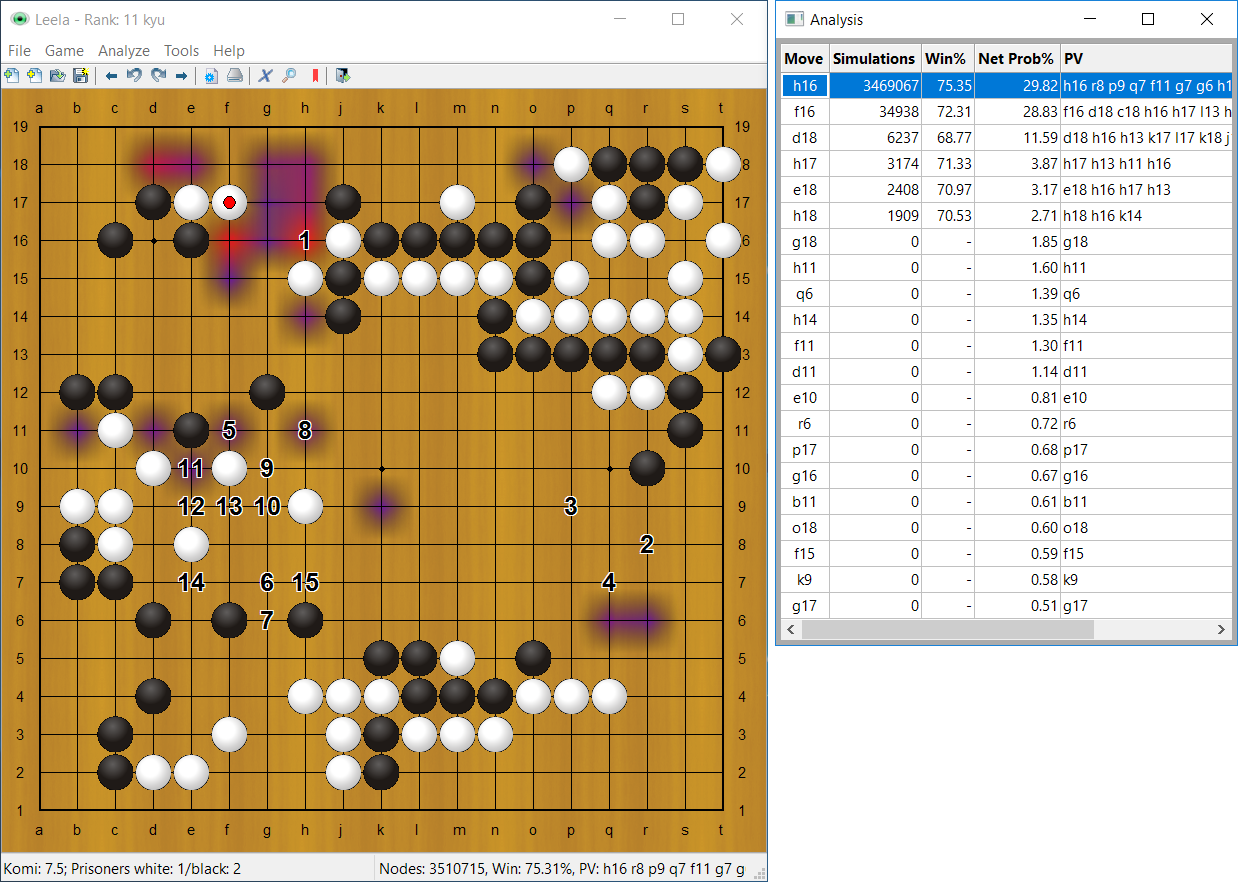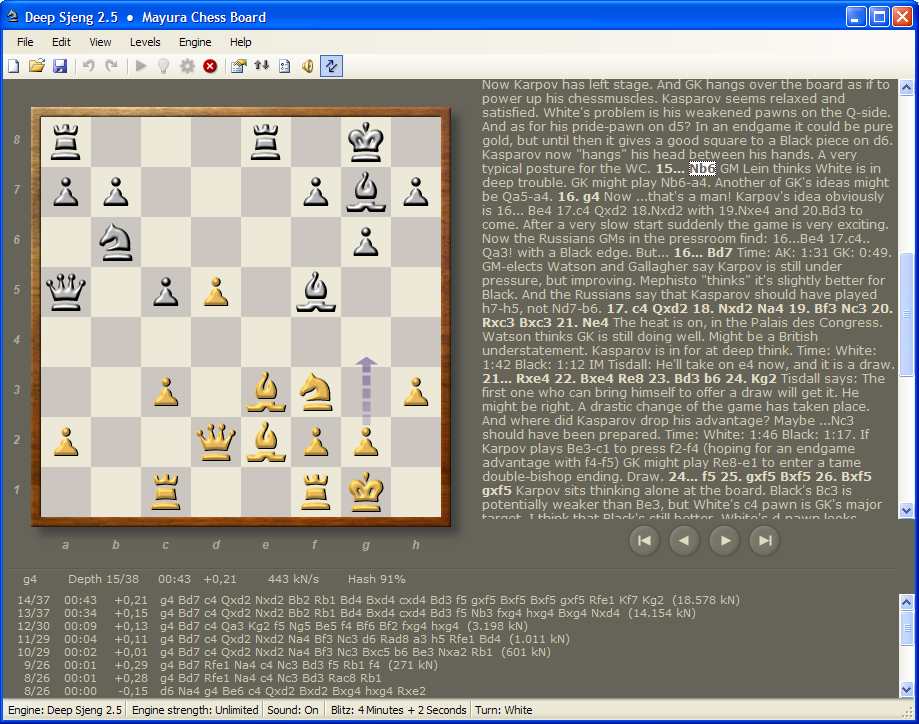Deep Sjeng Chess Engine Download
Newer versions of Sjeng also play standard, suicide, giveaway and losers chess. Deep Sjeng is a professional chess playing & analysis program, complete with interface, opening book, chess server access, personalities, multiprocessor and UCI support, and more. Its playing strength is over 2750 ELO on fast hardware.
The Chess Engine Communication Protocol is an open that enables a to communicate with its. It was designed by, the author of. It was initially intended to only communicate with the engine which only accepted text input and produced text output. In fact, the first version of this protocol is nothing more than the behavior of GNU Chess's. XBoard, using the protocol, 'wrapped around' GNU Chess by feeding the engine the expected text input, parsing the text output, and presenting this information on a graphical chess board.
Since its early days, the protocol has grown more robust and now supports standard chess games along with various chess variants including Wild Castle, No Castle, Two Kings, and. The protocol also supports three different styles of: conventional clocks, incremental clocks (Fischer Delay), and exact seconds per move. As of 2006, there are more than 300 chess engines (including GNU Chess and ) and 30 chess interface programs (including XBoard itself and ) that support this protocol with varying degrees of compatibility. As of 2008 work is being done to update the Chess Engine Communication Protocol with some convenient features such as the ability to set memory usage and the number of search threads (the latter is essential for architectures). CHESS ENGINE TO DOWNLOAD FOR FREE File archiver 7-Zip File Manager. Language patch football manager 2005.
(UCI) is an open that enables a 's engine to communicate with its. It was designed and released by Rudolf Huber and, the author of, in November 2000, and can be seen as a rival to the older XBoard/ Communication protocol. Like the latter, it is free to use without license fees. Customarily, UCI assigns some tasks to the user interface that have traditionally been handled by the engine itself. Most notably, the is usually expected to be handled by the interface, by simply selecting moves to play until it is out of book, and only then starting up the engine for calculation in the resulting position.
(UCI does not specify any on-disk format for the opening book; different usually have their own, proprietary formats.) Also, the user interface may handle if the engine does not support it itself, although this is often better handled in the engine, as having tablebase information can be useful to consider a possible future position. Only a few interfaces and engines supported this protocol until, the chess software company which markets, began to support UCI in 2002. As of 2007, there are well over 100 engines that support UCI. When chess engines are discussed, there is a tendency among reviewers to overdo the hyperbole.
Part of this is natural enthusiasm, but one does get tired of watching one engine or another come out on top, depending on who runs the test, the conditions, opening books used, etc (no offense to engine testers intended). Occasionally there is some consensus that one engine is better than the others. This happened with some versions of Fritz, and with Shredder. However, the situation is now slightly different with Rybka.
This engine, with it's very modest and unassuming name (roughly translated as 'fish' in many Slavic languages) has done more than produce agreement among the majority - in the case of Rybka, almost everyone agrees that it's the strongest engine, bar none. Furthermore, Rybka's rating is around 100 ELO over the next strongest engine. So this is not a matter of a small increase - this is a large jump in playing strength and it accounts for the wide agreement as to the engine's robustness.
Indeed, one is hard pressed not to find a rating list in which Rybka holds the top spot (see rating list). States that the ELO on this engine is over 3000. This is probably quite close to the mark.
The program's author, IM Vasik Rajlich, states that the reason for this leap in playing strength is Rybka's evaluation function, which is purported to be different in conception from any other chess engine. Of course, we'll never know for sure - and every engine programmer is certainly entitled to keeping a secret or two. Of course, it certainly doesn't hurt that Jeroen Noomen (of Rebel fame) designed the opening book for Rybka. Even so, without the benefit of this opening book, Rybka is still incredibly strong. Convekta has really pulled it off with Rybka.
It is without a doubt the strongest engine available today. And it's simply great that the engine is available in a UCI version, which ensures compatibility with every popular GUI out there (Arena, Chessbase, Fritz, Shredder, Chess Assistant, etc). If you do purchase the engine for use in Chess Assistant, make sure you read the engine setup notes below. Engine setup notes: Installation of this engine has to be done manually, and the documentation for doing this is located on the CD. It's not a difficult procedure but I think it would be nice for future versions to have a setup program. I also noted that the instructions made reference to setting the engine type to be 'Rybka'. However, in the version of Chess Assistant that I'm using (9.03 as of this writing), there is no Rybka engine type, so you should select DLL (UCI) as engine type in the engine's setup dialog box (but only if you're using the dll version).
If you're using the executable version, then you need to set the engine type to 'UCI'. Personality Settings for Optimal use with Chess Assistant (Tools-Engine's Setup-Personalities) As can be seen in the above screenshot, Rybka has a number of interesting settings.
There are a few that I'd like to call attention to. The first of these is the setting for limiting playing strength.
Note that you must adjust both the playing strength slider (UCIElo) and check the 'UCILimitStrength' box to use this feature. You also might want to adjust the time settings on the right hand side of the screen, especially if you find that Rybka is playing too quickly for you. Rybkachess.com has a good FAQ that discusses some of these settings. I would also suggest checking the 'Preserve Analysis' box. If you are planning to use Rybka for either the background analysis or interactive analysis functions within Chess Assistant. These functions make heavy use of hash tables and previously analyzed positions.
Don't forget to uncheck 'UCILimitStrength' if you're using Rybka for analysis - CHESS ENGINE INSTALATION FOR JUNIOR / FRITZ / Chess Base GUI GUI = (Graphical User Interface = program to display chess analysis) Follow steps described below: STEP 1 Copy chess engine to directory on your computer. STEP 2 Open Junior / Fritz / Chess Base GUI. STEP 3 As shown in picture below click on ENGINE then click on CREATE UCI ENGINE STEP 4 You will see something similar to this picture: Find directory where you had copy RYBKA engine. Underline and click on engine file i.e. Rybka v2.2.w32.exe Click open. You should see: Click OK. You install Rybka engine inside Fritz GUI.
If you see the error message 'Engine: could not load' make sure that you want to install the right Rybka version (the 64-bit version needs a computer and operating system that supports 64-bit) and if there's still this error, you should try to remove the path to the Nalimov endgame tablebases in the options for the installation (restart Fritz after removing the path). This seems to be a bug in Fritz. STEP 5 Now, you have to only change an engine.
Sjeng Sports

Leela Sjeng
To do it click on icon of the engine you are currently using. On the picture below it is Junior 9 In a gray window 'Load engine' which will appear you will see list of engines. Pick the one you want to analyze chess with and click OK. In gray window you can also choose the numbers of MB for hash tables according to the type of computer you have. Rybka engine uses this memory (MB) to remember the positions it has searched, so a bigger hash table will slightly increase its level. Just make sure that your computer has enough memory for the hash tables well as any other applications (programs) which are running (i.e. Music in the background).
Deep Sjeng Chess Engine Download
If you set the hash table size too high, the operating system will start using the hard drive, which you definitely want to avoid. If you're not sure, choose a small value. If you choose to big number for your hash table it can slow down the engine. You are finally done. Enjoy your chess analysis - What is the best chess engine?

CCRL 40/40 Rating List — All engines. 2011.09.11 This is the ranking of a tourney of the best. Just a 'one on one' of the best 23 engines. Nothing else!





